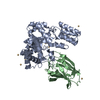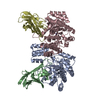[English] 日本語
 Yorodumi
Yorodumi- PDB-8umc: Deinococcus aerius TR0125 C-glucosyl deglycosidase (CGD), cryo-EM -
+ Open data
Open data
- Basic information
Basic information
| Entry | Database: PDB / ID: 8umc | ||||||||||||||||||
|---|---|---|---|---|---|---|---|---|---|---|---|---|---|---|---|---|---|---|---|
| Title | Deinococcus aerius TR0125 C-glucosyl deglycosidase (CGD), cryo-EM | ||||||||||||||||||
 Components Components |
| ||||||||||||||||||
 Keywords Keywords | LYASE / bacterial C-glucosyl deglycosidase / C-C bond cleavage / C-glucosyl aromatic polyketides / C-glucosyl flavonoids / Deinococcus aerius / soil bacterium / N-terminal DUF6379 beta-sandwich domain / C-terminal TIM-barrel domain / alpha2beta2 heterotetramer | ||||||||||||||||||
| Function / homology |  Function and homology information Function and homology information | ||||||||||||||||||
| Biological species |  Deinococcus aerius (bacteria) Deinococcus aerius (bacteria) | ||||||||||||||||||
| Method | ELECTRON MICROSCOPY / single particle reconstruction / cryo EM / Resolution: 2.5 Å | ||||||||||||||||||
 Authors Authors | Furlanetto, V. / Kalyani, D.C. / Kostelac, A. / Haltrich, D. / Hallberg, B.M. / Divne, C. | ||||||||||||||||||
| Funding support |  Sweden, Sweden,  Austria, 5items Austria, 5items
| ||||||||||||||||||
 Citation Citation |  Journal: J Mol Biol / Year: 2024 Journal: J Mol Biol / Year: 2024Title: Structural and Functional Characterization of a Gene Cluster Responsible for Deglycosylation of C-glucosyl Flavonoids and Xanthonoids by Deinococcus aerius. Authors: Valentina Furlanetto / Dayanand C Kalyani / Anja Kostelac / Jolanta Puc / Dietmar Haltrich / B Martin Hällberg / Christina Divne /   Abstract: Plant C-glycosylated aromatic polyketides are important for plant and animal health. These are specialized metabolites that perform functions both within the plant, and in interaction with soil or ...Plant C-glycosylated aromatic polyketides are important for plant and animal health. These are specialized metabolites that perform functions both within the plant, and in interaction with soil or intestinal microbes. Despite the importance of these plant compounds, there is still limited knowledge of how they are metabolized. The Gram-positive aerobic soil bacterium Deinococcus aerius strain TR0125 and other Deinococcus species thrive in a wide range of harsh environments. In this work, we identified a C-glycoside deglycosylation gene cluster in the genome of D. aerius. The cluster includes three genes coding for a GMC-type oxidoreductase (DaCGO1) that oxidizes the glucosyl C3 position in aromatic C-glucosyl compounds, which in turn provides the substrate for the C-glycoside deglycosidase (DaCGD; composed of α+β subunits) that cleaves the glucosyl-aglycone C-C bond. Our results from size-exclusion chromatography, single particle cryo-electron microscopy and X-ray crystallography show that DaCGD is an αβ heterotetramer, which represents a novel oligomeric state among bacterial CGDs. Importantly, the high-resolution X-ray structure of DaCGD provides valuable insights into the activation of the catalytic hydroxide ion by Lys261. DaCGO1 is specific for the 6-C-glucosyl flavones isovitexin, isoorientin and the 2-C-glucosyl xanthonoid mangiferin, and the subsequent C-C-bond cleavage by DaCGD generated apigenin, luteolin and norathyriol, respectively. Of the substrates tested, isovitexin was the preferred substrate (DaCGO1, K 0.047 mM, k 51 min; DaCGO1/DaCGD, K 0.083 mM, k 0.42 min). | ||||||||||||||||||
| History |
|
- Structure visualization
Structure visualization
| Structure viewer | Molecule:  Molmil Molmil Jmol/JSmol Jmol/JSmol |
|---|
- Downloads & links
Downloads & links
- Download
Download
| PDBx/mmCIF format |  8umc.cif.gz 8umc.cif.gz | 182.7 KB | Display |  PDBx/mmCIF format PDBx/mmCIF format |
|---|---|---|---|---|
| PDB format |  pdb8umc.ent.gz pdb8umc.ent.gz | 145 KB | Display |  PDB format PDB format |
| PDBx/mmJSON format |  8umc.json.gz 8umc.json.gz | Tree view |  PDBx/mmJSON format PDBx/mmJSON format | |
| Others |  Other downloads Other downloads |
-Validation report
| Summary document |  8umc_validation.pdf.gz 8umc_validation.pdf.gz | 1.1 MB | Display |  wwPDB validaton report wwPDB validaton report |
|---|---|---|---|---|
| Full document |  8umc_full_validation.pdf.gz 8umc_full_validation.pdf.gz | 1.1 MB | Display | |
| Data in XML |  8umc_validation.xml.gz 8umc_validation.xml.gz | 39.6 KB | Display | |
| Data in CIF |  8umc_validation.cif.gz 8umc_validation.cif.gz | 58.9 KB | Display | |
| Arichive directory |  https://data.pdbj.org/pub/pdb/validation_reports/um/8umc https://data.pdbj.org/pub/pdb/validation_reports/um/8umc ftp://data.pdbj.org/pub/pdb/validation_reports/um/8umc ftp://data.pdbj.org/pub/pdb/validation_reports/um/8umc | HTTPS FTP |
-Related structure data
| Related structure data |  42375MC  8qvcC  8qvdC  8qveC M: map data used to model this data C: citing same article ( |
|---|---|
| Similar structure data | Similarity search - Function & homology  F&H Search F&H Search |
- Links
Links
- Assembly
Assembly
| Deposited unit | 
|
|---|---|
| 1 |
|
- Components
Components
| #1: Protein | Mass: 40554.328 Da / Num. of mol.: 2 Source method: isolated from a genetically manipulated source Source: (gene. exp.)  Deinococcus aerius (bacteria) / Strain: TR0125 / Gene: DAERI_200053 / Plasmid: pNIC-CTHO / Production host: Deinococcus aerius (bacteria) / Strain: TR0125 / Gene: DAERI_200053 / Plasmid: pNIC-CTHO / Production host:  #2: Protein | Mass: 13755.647 Da / Num. of mol.: 2 Source method: isolated from a genetically manipulated source Source: (gene. exp.)  Deinococcus aerius (bacteria) / Strain: TR0125 / Gene: DAERI_200052 / Plasmid: 2A-T / Production host: Deinococcus aerius (bacteria) / Strain: TR0125 / Gene: DAERI_200052 / Plasmid: 2A-T / Production host:  #3: Chemical | Has ligand of interest | N | |
|---|
-Experimental details
-Experiment
| Experiment | Method: ELECTRON MICROSCOPY |
|---|---|
| EM experiment | Aggregation state: PARTICLE / 3D reconstruction method: single particle reconstruction |
- Sample preparation
Sample preparation
| Component | Name: C-glucosyl deglycosidase, alpha subunit / Type: COMPLEX Details: The complex contains two alpha subunits and two beta subunits that form an alpha2beta2 heteroteramer Entity ID: #1-#2 / Source: RECOMBINANT |
|---|---|
| Molecular weight | Experimental value: NO |
| Source (natural) | Organism:  Deinococcus aerius (bacteria) / Strain: TR0125 Deinococcus aerius (bacteria) / Strain: TR0125 |
| Source (recombinant) | Organism:  |
| Buffer solution | pH: 7.5 |
| Specimen | Conc.: 1 mg/ml / Embedding applied: NO / Shadowing applied: NO / Staining applied: NO / Vitrification applied: YES |
| Specimen support | Grid material: GOLD / Grid mesh size: 300 divisions/in. / Grid type: UltrAuFoil |
| Vitrification | Cryogen name: ETHANE |
- Electron microscopy imaging
Electron microscopy imaging
| Experimental equipment |  Model: Titan Krios / Image courtesy: FEI Company |
|---|---|
| Microscopy | Model: TFS KRIOS Details: Data collected at the Karolinska Institutet 3D-EM facility |
| Electron gun | Electron source:  FIELD EMISSION GUN / Accelerating voltage: 300 kV / Illumination mode: FLOOD BEAM FIELD EMISSION GUN / Accelerating voltage: 300 kV / Illumination mode: FLOOD BEAM |
| Electron lens | Mode: BRIGHT FIELD / Nominal defocus max: 3000 nm / Nominal defocus min: 200 nm / Cs: 2.7 mm / C2 aperture diameter: 20 µm / Alignment procedure: ZEMLIN TABLEAU |
| Specimen holder | Cryogen: NITROGEN / Specimen holder model: FEI TITAN KRIOS AUTOGRID HOLDER |
| Image recording | Average exposure time: 1.5 sec. / Electron dose: 56 e/Å2 / Film or detector model: GATAN K3 BIOQUANTUM (6k x 4k) / Num. of grids imaged: 1 / Num. of real images: 2153 |
| EM imaging optics | Energyfilter name: GIF Bioquantum / Energyfilter slit width: 10 eV |
- Processing
Processing
| EM software |
| ||||||||||||||||||||||||||||
|---|---|---|---|---|---|---|---|---|---|---|---|---|---|---|---|---|---|---|---|---|---|---|---|---|---|---|---|---|---|
| CTF correction | Type: PHASE FLIPPING AND AMPLITUDE CORRECTION | ||||||||||||||||||||||||||||
| Particle selection | Num. of particles selected: 335185 | ||||||||||||||||||||||||||||
| Symmetry | Point symmetry: C2 (2 fold cyclic) | ||||||||||||||||||||||||||||
| 3D reconstruction | Resolution: 2.5 Å / Resolution method: FSC 0.143 CUT-OFF / Num. of particles: 101068 / Algorithm: BACK PROJECTION / Symmetry type: POINT |
 Movie
Movie Controller
Controller


 PDBj
PDBj


